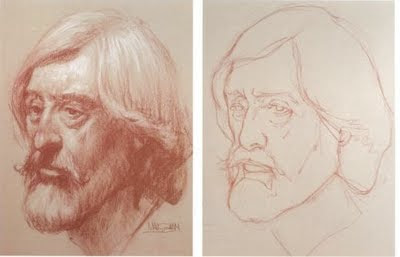Friday, December 31, 2010
2011 Oil Painting Class Calendar
Tuesday, November 30, 2010
December Class Syllabus
Saturday, November 27, 2010
The Gauntlet is Re-thrown!
Wednesday, November 24, 2010
Realism Show at Laguna Wendt Gallery in December
December 2 - 27, 2010
Open Reception: Thursday, December 2 from 6 - 9 pm
A group exhibition featuring works by:
Joshua Langstaff
David Gray
Bryan Larsen
George Gonzalez
Glenn Harrington
Cesar Santos
Peter Van Dyke
Serge Marshennikoff
Tang Wei Min
Patrick Devonas
Jeffrey Hein
Casey Baugh
Juliette Aristides
Monday, November 22, 2010
Sonoma Plein Air Festival
Please join us this spring for a week in the beautiful wine country of Sonoma Valley! It all happens at the 7th annual Sonoma Plein Air Festival, May 23-28, 2011.
Application Deadline: January 26, 2011
Application Fee: $50.00
Paint on location in private estates, wineries and coastal locations. Our area is chock-full of vintage barns, Victorian houses and water towers, eucalyptus groves and meadows dotted with Valley oaks, rolling grassy hills and wooded waterways - Plein Air heaven. Commune with other Plein Air artists from around the country.
We provide complimentary lodging, maps, suggested scenic locations,welcome wine reception, many meals, ticket to the Gala on Friday, and much more.
What's That Twitter Feed
Friday, November 19, 2010
Our Usual Palette
Colley Whisson's Supply List
Colley paints on a variety of surfaces, both board and canvas panel. The board was primed with amber shellac. The canvas was primed with acrylic gesso sometimes toned with a light wash of acrylic paint in red ochre. It does not matter what the surface, Colley is a master painter.
We will use our usual palette in December, but give the medium and larger flats and liner a try. A substitute for the Archival Oil Lean is Gamblin Galkyd Painting Medium. It is slightly thicker in consistency but can be thinned with OMS (Odorless Mineral Spirits). When using either, keep your brushes clean as you work, because the paint will set in your brush much more quickly than when working with paint alone.
David Curtis, "Painting with Impact"
Thursday, November 4, 2010
Earth Reds
Thursday, October 14, 2010
What I'm Up To
Sunday, October 10, 2010
Reference Books for Drawing the Head

Saturday, October 9, 2010
Portrait Reference
Tuesday, October 5, 2010
Monet Exhibit
Friday, September 24, 2010
Class Starts October 13th
Tuesday, August 10, 2010
Frame Source in Irvine
Thursday, August 5, 2010
Compose It Grid
Monday, August 2, 2010
Let It Go

Friday, July 16, 2010
Mini Comps - Color Notation on Site
Tuesday, July 13, 2010
Class Syllabus July 2010
- We have the classroom for the full day this month, so paint into the afternoon.
- Class meets on 7/14, 7/21 & 7/21.
- I will hand out invoices on 7/14 for $105.
- Adria will be back east this month for Marlena's second surgery. Marlena and Adria, you are in our thoughts.
Reference Books for Landscape Painting
Sunday, July 11, 2010
Shawn Mckelvey at the Ralph Love Plein Air Festival

Thursday, June 24, 2010
July Critique Session for Artists
Tuesday, June 15, 2010
Impressionism at the De Young
June 3, 2010, The Week Magazine
De Young Museum, San Francisco, through Sept. 6
"Birth of Impressionism: Masterpieces from the Musee d'Orsay"
While the Musée d’Orsay undergoes renovations, two exhibitions assembled from its collection of impressionist paintings will travel the world. The De Young Museum in San Francisco is the only musuem that will host both.
While its historic building undergoes renovations, Paris’ Musée d’Orsay “is taking its act on the road,” said Charlie McCullom in the San Jose Mercury News. The world’s most important collection of impressionist and other 19th-century French art “has packed up its Monets and Manets, its Cézannes and Renoirs, even that painting of Whistler’s mom.” Two exhibitions assembled from the collection will be crisscrossing the globe this year, “but only one museum in the world will host both”: San Francisco’s de Young Museum. The first show to visit the de Young attempts to trace the creation of the impressionist movement by showing some of its finest exemplars alongside lesser-known contemporaries.
“Rather than presenting a mere hit parade,” the show illuminates what was truly so different about the impressionists, said Janos Gereben in the San Francisco Examiner. The then-dominant art style, academic painting, rendered historical and mythological scenes in a polished but often lifeless style. The impressionists introduced an appreciation of “visible brush strokes, an emphasis on changing light and movement, and a focus on everyday people.” Paintings such as Édouard Manet’s The Fifer and Gustave Caillebotte’s The Floor-Scrapers challenged viewers by showing them humble subjects from the real world. Likewise, artists such as Paul Cézanne confronted them with a style that seemed almost primitive, said Jennifer Modenessi in the Contra Costa, Calif., Times. The indistinct forms and rough surfaces of his Gulf of Marseille Seen From L’Estaque “must have looked very strange to people accustomed to slick, highly finished paintings.” It can be hard for today’s museumgoers, long accustomed to the impressionists’ innovations, to “look at these famous works of art with fresh eyes.”
It may be even harder for us to give the impressionists’ predecessors a fair shake, said Kenneth Baker in the San Francisco Chronicle. Take Adolphe-William Bouguereau’s Birth of Venus—an airy mythological scene that has all the “calculated false feeling, historical irrelevance,” and other qualities that the impressionists hated. Even if you agree with their judgments, however, you “must admire the technical dexterity” of such a work. This exhibition defines the fault lines between traditionalists and innovators, but also points out the complex connections among, say, mythologists like Bouguereau, symbolists like Gustave Courbet, and impressionists like Pierre Auguste Renoir. “Forget nomenclature for a while, and look hard at the rich range and variety of physical detail in the paintings.” Unless you travel to Paris, you’ll never see their likes again.
Wednesday, June 2, 2010
Len Chmiel - Part 2








Shawn McKelvey at the Merc





















